Regional Newsletters
August 2020 Statewide Newsletter

Closing in on 1,100 Weekly Workers… and Counting
Heading into Labor Day weekend, we are proud of the hard-working men and women helping to bring high-speed rail to California. This June, we announced that more than 4,000 construction jobs have been created at the more than 32 active construction sites along the system’s first 119 miles of the high-speed rail project…and that number keeps growing! Over the past year and a half, we have quadrupled the number of workers dispatched to our construction sites, averaging more than 1,100 workers weekly at sites in July, a 149% increase compared to August 2019, just one year ago. Please join us in recognizing the hard work of American laborers that help with the development, growth and prosperity of our country. Check out the Authority’s most recent construction update.

August 2020 CEO Report
Los Angeles Union Station Update
Funding Plan: At the April 2020 Board of Directors meeting, the Board approved the Funding Plan for Phase A of the Los Angeles Union Station Project – referred to as “Link US.” The Funding Plan directs $423.3 million in Proposition 1A bond funds to the project, which has a total Phase A budget of $950.4 million. The Authority is now working with LA Metro to develop a Project Management Funding Agreement, which we will bring to the Board for approval.
Change in Procurement Status: On July 10, LA Metro notified industry that it will cancel its current Request for Qualifications (RFQ) and re-issue the RFQ with a revised Construction Manager/General Contractor (CM/GC) integrated delivery approach for the project. Specifically, Metro is changing from a “not to exceed price” to a more traditional approach similar to the one that the Authority used in delivering the State Route 99 Realignment Project in the Central Valley. Authority staff have discussed this change with LA Metro staff, who have indicated this change is warranted given COVID-19, financial, and other considerations. The Project Budget is expected to stay the same, and the Authority’s funding contribution remains capped at the $423.3 million in Proposition 1A funds and $18.7 million in planning funds.
Palmdale to Burbank Preferred Alternative Adjustment
In November 2018, the Board of Directors identified a Preferred Alternative for the 41-mile segment of the Phase 1 system between the Palmdale Transit Center and the Burbank Airport Station in Southern California. For environmental review and planning purposes, we refer to this project section as “Palmdale-to-Burbank.” The Preferred Alternative included a direct impact on Una Lake, a body of water near Palmdale.
After consultation with the United States Environmental Protection Agency (USEPA) and the United States Environmental Protection Agency, under the authority delegated to the CEO by the Board, I approved an amendment to the Preferred Alternative adopted in 2018 to achieve the objective of avoiding impacts to Una Lake.
Staff is continuing to advance the environmental work and the Draft Environmental Impact/Statement (EIR/EIS) will be issued for public comment in 2021.
A link to the PowerPoint presentation associated with this topic can be found here: PowerPoint: Palmdale to Burbank Amendment to the Preferred Alternative.
Construction/Program Updates
I am pleased to provide two updates on program advancements.
Agreement with Madera County: Staff recently completed an agreement with Madera County related to the fulfillment of the Authority’s commitment to remediating construction impacts to local roads and the County immediately opening several roads where work has recently been completed work (at Avenues 7, 10 and 15) and accepting ownership and maintenance obligations for all completed structures at Avenues 7, 8, 10,11 and 15. Avenues 8 and 11 are currently open to the public. The opening of these roads allows additional work to progress on our project.
Collaborating with “Fresno Works” to Secure Maintenance of Way Site: As we build out the full Phase 1 system connecting San Francisco to Los Angeles/Anaheim, we anticipate requiring three separate Maintenance of Way Facilities to support the system. In the Fresno-Bakersfield Final EIR/EIS approved by the Board of Directors in 2012, the Authority identified and environmentally cleared the first of these sites just south of downtown Fresno. The site will also contain the Operational Control Center (OCC), a temporary trainset acceptance testing and certification facility and will include training classrooms and support equipment, such as simulators.
Our Central Valley staff is working closely with Board Member Perea and a group of business and local government representatives in Fresno known as “Fresno Works” to secure the site for these activities and to preserve a local investment of $25 million to accelerate infrastructure improvements to the site and help ready it for future job-generating activities. These facilities are proposed to be constructed by the Track and Systems contractor that we are currently in the process of procuring. As part of this procurement process, the Authority is required to instruct the bidders where these facilities will be located.
Look-Ahead Issues
The Board of Director’s September meeting will have a full agenda of both action and informational items, including:
- Action: Central Valley “Wye” Final Supplemental EIR/EIS
- Update: Environmental Schedules for all remaining Phase 1 project sections (San Francisco – Los Angeles/Anaheim)
- Presentation: Intrusion Protection Barrier (IPB) Safety Requirements for the Central Valley Construction Packages (CP 1, CP 2-3 and CP 4)
- Discussion: Procurement Process/Options for the Rail Delivery Partner (RDP) Contract
To view the August 2020 CEO Report in its entirety, visit https://hsr.ca.gov/about/board/ceo_report.aspx.
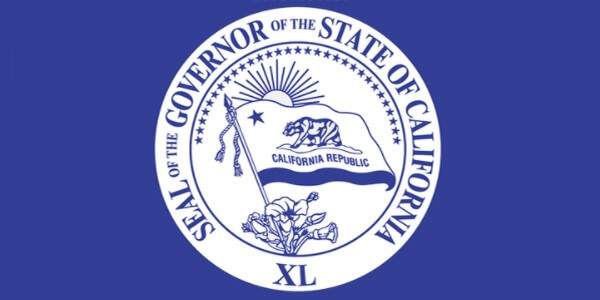
Governor Gavin Newsom Announces High-Speed Rail Board Appointments
Nancy C. Miller of Sacramento and Lynn Schenk of San Diego have been reappointed to the California High-Speed Rail Authority Board of Directors; Anthony C. Williams of Orange has been appointed to the California High-Speed Rail Authority Board of Directors. Read more about these appointees at the website for the Office of Governor Gavin Newsom.
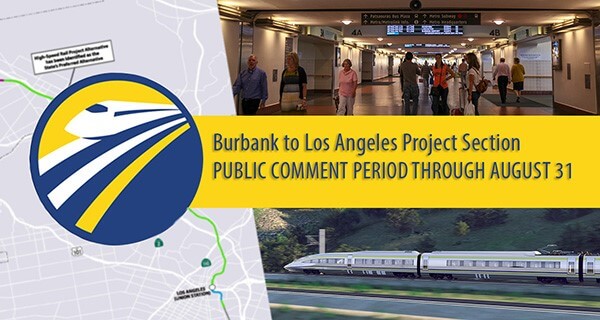
Environmental Progress Update
The Authority kicked off 2020 with an ambitious schedule to issue several environmental documents that are part of the process of identifying the final route of the high-speed rail line from San Francisco down to the Los Angeles/Anaheim area.
Starting in February, we issued the Bakersfield to Palmdale Draft Environmental Impact Report/Environmental Impact Statement (EIR/EIS), and in April, we issued the San Jose to Merced Draft EIR/EIS document. Those comment periods have closed, with final documents due out next year. Currently out on the street for public review and comment are the Burbank to Los Angeles EIR/EIS and the San Francisco to San Jose EIR/EIS documents, with their comment periods closing at the end of August and early September respectively.
At the same time we started issuing the documents, the COVID-19 pandemic was taking hold, and we had to adjust to the new normal along with so many others. To support this effort, we have held dozens of virtual open houses and meetings to make sure the public has an opportunity to view the documents, speak with the experts, and provide their feedback on the routes and potential impacts to their communities.
One of most significant environmental actions will be happening in September at the Board of Directors meeting. At that meeting, the Board will be asked to take action on the Central Valley “Wye” Final Supplemental EIR/EIS, which has currently been published. At that same meeting, we will also be providing an update on the environmental schedules for all remaining Phase 1 project sections (San Francisco – Los Angeles/Anaheim).
Although COVID-19 has changed the way we do business, we remain committed to completing all environmental review work by the end of 2022, allowing us to meet our federal grant requirements and ensuring that these project sections are ready so we can move forward on construction as soon as possible when additional funds become available.
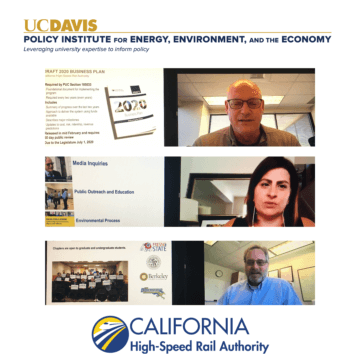
UC Davis Policy Institute Welcomes High-Speed Rail Executives
Members of the California High-Speed Rail Authority (Authority) executive team chatted with leaders of the University of California, Davis (UC Davis) Policy Institute for Energy, Environment and the Economy as part of the Policy and Popcorn event. The event is hosted at UC Davis about twice a month, bringing together policy leaders from around California to connect with UC Davis students and affiliates in policy conversations with popcorn snacks. Organizers of the event rose to the occasion when COVID-19 caused universities to cancel many events. In a quick transition to a virtual platform, UC Davis leaders created an online space for the campus community to engage with the Authority’s executive team – minus the popcorn.
Starting off the event, the Authority’s CEO Brian Kelly gave a statewide overview of high-speed rail in California and the guiding principles that the Authority follows. The presentation continued with CFO Brian Annis discussing funding sources for the California High-Speed Rail program and some of the complexities associated with funding the project. To close the presentation, Chief of Communications Melissa Figueroa highlighted ways for students to stay engaged with the high-speed rail project through student chapters, newsletters and social media.
Leaders of the UC Davis Policy Institute closed the event by asking, “What research questions do you think the research community should be asking?” Captivated with the question – the executive team discussed the need to research the transformative effects that electric high-speed passenger rail brings to communities through jobs, sustainability benefits to the environment and connecting California’s regions. Above all, the question highlighted an important point – academic communities are a vital part of high-speed rail development in California.
If your university and/or college group would like to engage with the Authority through presentations, panels, webinars or student gatherings – sign up for a presenter through the Speakers Bureau.
Northern California Regional Update
August 2020
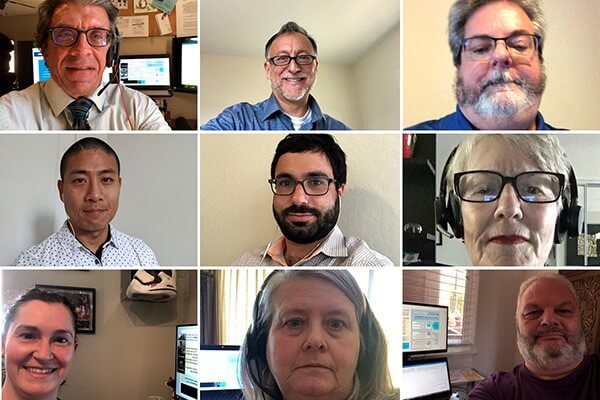
California High-Speed Rail Achieves Second Major Milestone in the Bay Area
The California High-Speed Rail Authority released its second project-level EIR/EIS Draft Environmental Document for a project section in Northern California on July 10, 2020. The document covers the 51-mile segment extending from the Caltrain Station at 4th and King Streets in San Francisco to Diridon Station in San Jose.
The San Francisco to San Jose Project Section will provide the public with electric-powered high-speed rail service that provides predictable and consistent travel times between major urban centers and connectivity to airports, mass transit systems, and the highway network stretching from San Francisco to San Jose. It will also help connect the northern and southern portions of the statewide HSR system.
To view press release, visit https://hsr.ca.gov/communication/news_room/news_releases/?id=50.
In response to the COVID-19 pandemic, the Authority has launched an online web portal to help the public better understand the EIR/EIS document.
The Authority also announced the public review period for the San Francisco to San Jose Draft Environmental Impact Report/Environmental Impact Statement (EIR/EIS) has been extended to September 9, 2020.
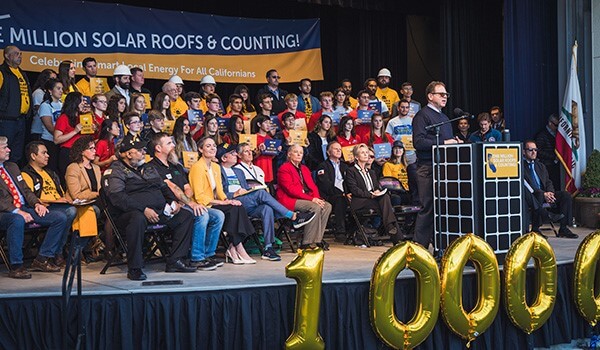
Addressing Climate Change in Transportation
For 25 years, Rick Brown PhD, worked as a business and organizational strategy consultant, working mostly in the public sector. He made what was perhaps one of the most pivotal decisions of his career in 2005, when he was engaged by a national environmental organization to help them gain a better understanding of climate change and the impact it could ultimately have on their work.
“In delving into the research and science around climate change, I had an epiphany; that this is the most important issue out there that I could work on,” Brown recalled. “Something needs to change.”
A year later, when the federal government passed the solar investment tax credit and California passed its solar initiative, he helped convince the board of a low-income housing tax credit company client that it should explore investing in the solar tax credit financing business. That eventually led to the formation of MMA Renewable Ventures, one of the first financing companies for the solar industry.
Read more about Terra Verde in the Small Business Newsletter.
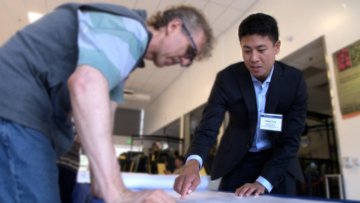
The Son of a Self-Professed Engine-Nerd
James Tung’s journey into a career in engineering can be measured as a testament to a parents’ influence in shaping the direction of their young teen.
When he was young and vacationing with his family, Tung distinctly remembers that while he and other family members were taking photos of buildings and other interest sites, his father, Edward, would aim his camera in an entirely different – and unusual – direction.
“I’d say my dad was the biggest inspiration,” said Tung, who endearingly referred to Edward Tung as an “engine-nerd.’ “He was a civil /electrical engineer. I saw him working on a lot of projects growing up.
“But anytime we went on vacation, we’d be taking pictures of buildings and my dad would be off to the side, taking pictures of OCS (overhead contact system) wires – wires that power the train.”
Read more about James Tung in the Small Business Newsletter.
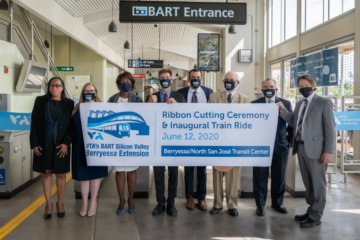
VTA and BART Celebrate Rapid Rail Service to Milpitas and San José
June 12 marked a celebration of epic proportions although you might not have been able to tell from the size of the crowd. But it was quality not quantity that counted in this case.
A few dozen attendees joined officials from the Santa Clara Valley Transportation Authority (VTA), San Francisco Bay Area Rapid Transit District (BART), and the cities of San José and Milpitas for the inaugural ride on the newest 10-mile BART extension into Santa Clara County.
Members of the public were invited to live-stream the event to maintain a small crowd and adhere to social distancing requirements. The first train for passengers departed on Saturday, June 13 at 7:56 a.m. bound for Richmond (BART Orange Line) from the Berryessa/North San José station and arrived at the Milpitas Station just three minutes later.
Read more about the BART extension into Santa Clara County on the Valley Transportation Authority’s website.
Southern California Regional Update
August 2020
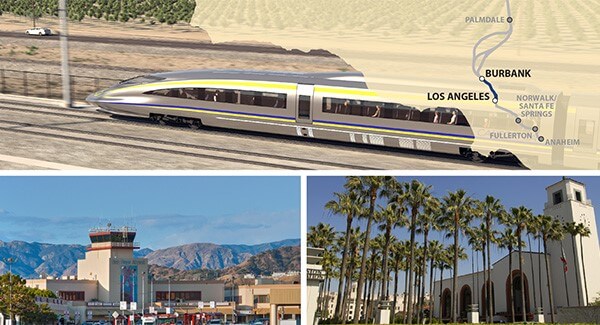
Southern California Updates
While high-speed rail construction progress continues in the Central Valley, in Southern California progress on completing the project’s environmental documents is also moving forward.
Since late 2019, the Authority has made steady progress in advancing environmental work, with the goal of having the entire system between Los Angeles/Anaheim to San Francisco fully cleared by the end of 2022.
As part of that clearance process, the Southern California segment has been divided into four smaller sections: Bakersfield to Palmdale, Palmdale to Burbank, Burbank to Los Angeles, and Los Angeles to Anaheim.
For the Bakersfield to Palmdale project section, the public review period for the Draft Environmental Impact Report/Environmental Impact Statement (EIR/EIS) closed on April 28. The high-speed rail Authority is now reviewing comments received from the public and will respond to those comments in a final EIR/EIS issued in 2021.
Given the restrictions placed on public gatherings and meetings with the COVID-19 pandemic, the Authority has refocused outreach efforts to digital, virtual, telephone and traditional mail outreach efforts.
For the Burbank to Los Angeles project section, numerous online public meetings have been held for the Draft EIR/EIS, which was released on May 29 and followed by two public comment extension periods (extending the total public comment for the section to 94 days). This period ends on August 31.
During this extension, Authority staff has continued to conduct outreach, offering online Authority-staffed office hours, telephone town halls and virtual meetings. While an August 19 Telephone Townhall reached more than 3,100 residents to answer questions and inform them on the environmental process, an August 25 online grade separation meeting provided further information about the program, with a focus on a proposed Main Street Grade Separation. Held at the request of local legislative representatives, extensive outreach was performed to ensure residents were aware of the opportunity to participate. Details are available at www.meethsrsocal.org.
For the Los Angeles to Anaheim project section, a revised Scoping Period began August 25. This will allow the Authority to make changes in the original environmental documents to include work that needs to take place to accommodate future growth in the project corridor.
The Los Angeles-Anaheim high-speed train corridor will travel along the BNSF-owned rail corridor between Los Angeles and Fullerton, which serves BNSF’s Hobart and Commerce Intermodal Facilities. In order to accommodate high speed rail service in the future, as well as provide for growth of existing passenger rail services, it is necessary to relocate a portion of freight rail service away from the Los Angeles to Fullerton corridor. This will be accomplished with the construction of new freight facilities in San Bernardino County, to support freight operations in Southern California.
The facilities are proposed to be located in Colton and in the Barstow area. The Colton Intermodal Facility will process some of the freight trains that were destined for the Los Angeles to Fullerton corridor to allow for continued efficient movement of freight in the region. The Lenwood Staging tracks will serve as a holding area for some of the freight trains destined for the Los Angeles to Fullerton corridor, until there is room in the corridor to accommodate them.
Virtual scoping meetings are being scheduled for September, so the public will have a chance to learn more about these changes. Details will be posted at www.meethsrsocal.org.
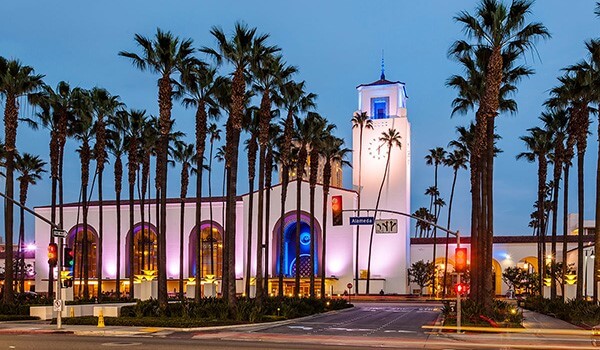
Los Angeles Union Station Rail Partners Take Innovative Steps to Cope with COVID-19
Union Station, the transportation hub for Southern California nestled in downtown LA, was bustling with rail riders in January of this year and rail service is still moving through the station but with limited schedules and a greatly reduced ridership for Metro (Los Angeles County Metropolitan Transportation Authority), and Metrolink (Southern California Regional Rail Authority).
Innovative measures have been incorporated by Metro and Metrolink to enhance and support the basic safety requirements for passengers to wear a mask and socially distance and ensure clean interior surfaces on a train.
Metro has deployed Customer Ambassadors to help passengers comply with the requirement to wear a mask and encourage safe riding. Licensed mask vendors who sell masks and hand sanitizer are in place at some Metro stations. Los Angeles Union Station’s popular Summer Events dance and music series now plays to a virtual audience.
Metrolink has introduced electrostatic sprayers that apply nontoxic disinfectant on all areas of passenger cars every day and doubled the number of hand sanitizer stations available to two in every car on every train. An enhanced cleaning crew conducts a daily and nightly deep train cleaning routine which includes disinfecting high touchpoint surfaces such as doors, restrooms, headrests, armrests, handrails, tables and trash areas. Train Tracker is Metrolink’s new online way to track the status of your train and tells the passenger how full the train is to help them determine if it’s feasible to socially distance.
It’s all aboard during COVID-19 at Metro and Metrolink for a safe and socially distanced ride.

Dean’s Certified Welding Torches Quality Welds Along High-Speed Rail Alignment
Even in the era of COVID-19, Dean’s Certified Welding Inc. shows no signs of easing up. That’s thanks in large part to a solid foundation laid nearly a half century ago by the firm’s original President and CEO Mike Dean.
“If you do what you say you’re going to do, and you do a good job, you can’t hardly fail,” said Dean, who launched the firm in 1973. “It’s really been kind of a fairy-tale story.”
The firm has evolved though the years. Initially, it started supplying field pipe welding to local Carlsbad tomato farmers. It built up one welder at a time over the decades and the Temecula-based firm currently employs about 60 California-based workers.
“We’ve had guys retire out of the company after 30 years,” said Dean, lamenting the ongoing struggle of finding and keeping skilled welders. “When people stick around for years and years like that, it means you’ve treated them right, taken care of them.”
Read more about Dean’s Certified Welding in the Small Business Newsletter at https://www.buildhsr.com/flipbook/vol_08_issue_03/default.html#page=6
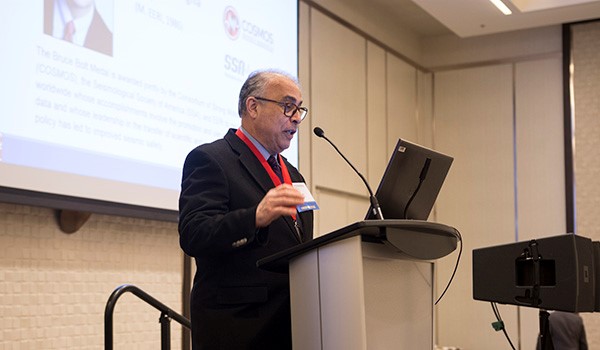
UCLA, Authority Partner to Conduct Essential Earthquake Research
The question often arises, is it possible to build high-speed rail up through the San Gabriel mountains into the Los Angeles Basin and down through the Pacheco Pass to the Northern end of the State through active earthquake faults? The UCLA Natural Hazards Risk and Resiliency Research Center (NHR3) informs designers globally with research to increase efficiency, lower risk and increase safety when building on earthquake faults. The NHR3 has contracted with the Authority to provide critical earthquake resiliency research for the construction of high-speed rail through diverse California terrains. Yousef Bozorgnia, Professor of Civil and Environmental Engineering at UCLA, looks with excitement and optimism to the partnership between the California High-Speed Rail Authority (Authority) and UCLA that will not only support the construction of high-speed rail in California, but also inform a global audience of infrastructure designers.
Read more about the UCLA and Authority partnership in an interview with Professor Bozorgnia in the Small Business Newsletter at https://www.buildhsr.com/flipbook/vol_08_issue_03/default.html#page=12.
Quarterly Newsletter Archive
- Spring 2023 All Aboard Newsletter
- Winter 2023 Quarterly Newsletter
- Fall 2022 Quarterly Newsletter
- Summer 2022 Quarterly Newsletter
- Spring 2022 Quarterly Newsletter
- Winter 2022 Quarterly Newsletter
- Fall 2021 Quarterly Newsletter
- Summer 2021 Quarterly Newsletter
- Regional Newsletter - May 2021
- Regional Newsletter - February 2021
- Regional Newsletter - November 2020
- Regional Newsletter - August 2020
- Regional Newsletter - June 2020
- Regional Newsletter - February 2020
- Regional Newsletter - November 2019
- Regional Newsletter - August 2019
- Summer 2023 All Aboard Quarterly Newsletter
- Fall 2023 All Aboard Quarterly Newsletter
- Winter 2022 Quarterly Newsletter
- Regional Newsletters – Aug 2019
- Regional Newsletters – Nov 2019
- Regional Newsletters – Feb 2020
- Regional Newsletters – June 2020
- Regional Newsletters – Aug 2020
- Regional Newsletters May 2021
- Fall 2021 Quarterly Newsletter
- Summer 2021 Quarterly Newsletter
- Spring 2022 Quarterly Newsletter
- Summer 2022 Quarterly Newsletter
- Regional Newsletters – Nov 2020
- Winter 2023 Quarterly Newsletter
- Regional Newsletters – Feb 2021
- Spring 2023 All Aboard Quarterly Newsletter
- Fall 2022 Quarterly Newsletter
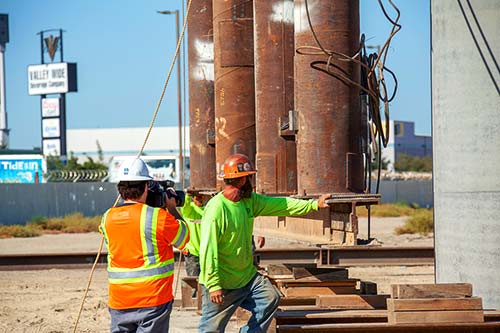
The California High-Speed Rail Authority makes every effort to ensure the website and its contents meet mandated ADA requirements as per the California State mandated Web Content Accessibility Guidelines 2.0 Level AA standard. If you are looking for a particular document not located on the California High-Speed Rail Authority website, you may make a request for the document under the Public Records Act through the Public Records Act page. If you have any questions about the website or its contents, please contact the Authority at info@hsr.ca.gov.


